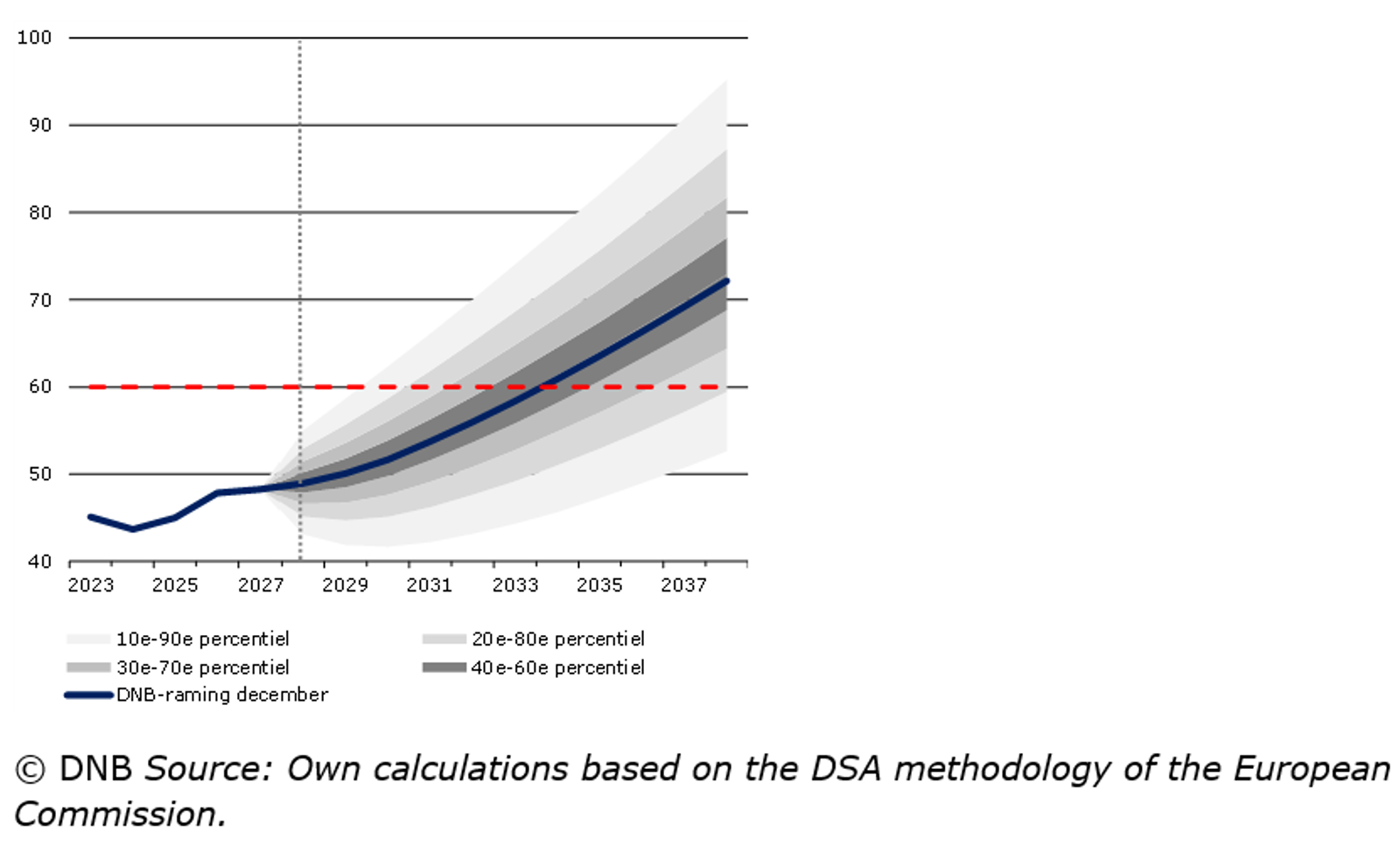
© ANP
Public finances
The Dutch government is financially in good shape, but the budget deficit and public debt will increase from 2025 onwards, leaving too little room to absorb economic shocks. In the longer term, population ageing and higher interest costs will put additional pressure on public finances.
European agreements on debts and deficits
When the euro was introduced in 1999, participating Member States made agreements on keeping their public finances in order. One of these agreements was that the budget deficit (the shortfall that occurs when the government spends more money than it takes in) should not exceed 3% of gross domestic product (GDP). GDP is the total value of all goods and services a country produces in a year. It was also agreed that public debt should not exceed 60% of GDP. These European fiscal rules are crucial for financial stability in the Netherlands and in the euro area. They help keep inflation and budget deficits under control.
Things are currently going well...
In 2024, the Dutch budget deficit was -0.9% of GDP. Public debt stood at 43% of GDP last year, the second-lowest level in 45 years (it was only lower in 2007). The Netherlands has a solid financial position, both compared to the past and to other countries.
...but the budget deficit is ticking upwards
Twice a year, DNB publishes projections for the Dutch economy. According to the 2025 Spring Projections, the budget deficit will rise to 2.8% of GDP this year. It is expected that the 3% deficit limit will be breached in 2026 when military pensions are converted to a new system, at a one-off cost to the government of €8.5 billion. The deficit is expected to be 3.5% of GDP in 2026 and 2.7% of GDP in 2027, respectively.
What causes the budget deficit to rise? Government spending is rising more rapidly than revenues from tax and social security contribution. Healthcare, social security, interest payments and defence are placing significant pressure on the government’s budget. Additionally, the economic outlook has become more uncertain, partly due to rising international tensions. These tensions could also pose additional risks to the stability of public finances.
Figure 1: Budget balance (left) and public debt (right)

© DNB
Public debt to grow, especially in the longer term
An ageing population increases the cost of state pension and health care. Interest expenditure is also set to increase, from 0.8% of GDP in 2025 to 1.9% of GDP in 2040. About two-thirds of this will be related to new debt and one-third to refinancing at higher interest rates. This would be exacerbated by ambitions to increase defence spending above the current 2% of GDP. As a result, Dutch government debt will rise above 60% in the longer term (Figure 2). The grey range shows the margin of uncertainty.
Figure 2: Dutch public debt is on an unsustainable path

© DNB
Lower economic growth expected
These rising expenditures will be harder to sustain as economic growth is expected to slow in the coming decades. Labour supply growth will be essentially flat due to the ageing of the labour force, and this lack of growth will not be offset by higher labour productivity growth for the time being. Based on this fact, a recent DNB Analysis (in Dutch) shows that annual economic growth in the Netherlands may remain well below 1% for the next few decades.
Build up buffers when the economy is going strong
As the economy is now doing comparatively well, the government should seize the opportunity to build up buffers. Doing so when the economy is strong and tapping into these reserves in times of economic malaise prevents the government from further fuelling an overheated economy with high spending, or from damaging a weak economy with austerity measures. This is called trend-based fiscal policy.
Under this policy, spending is fixed at the beginning of a government term, while tax revenues are allowed to move with the economy. In a sluggish economy, the budget deficit grows because of lower tax revenues in combination with a lack of austerity measures. And when the economy is doing well, the extra income is not immediately used for additional spending. As a result, the budget deficit falls. This keeps the government’s fiscal policy stable and predictable.
This is only possible if the country builds up sufficient reserves, which will ensure that the Netherlands remains below European deficit and debt thresholds even while pursuing this trend-based fiscal policy. This is all the more important in today’s uncertain economic environment. Want to know more? Read more about Dutch fiscal policy.
Cut spending or raise taxes?
To prevent public finances from deteriorating, the Fiscal Space Working Group – of which DNB is a member – advises the current government to reduce the deficit to around 2% of GDP and to stabilise debt below 60% of GDP in the longer term. This will put the Netherlands at a sufficient distance from the 3% threshold. The government will thus not be compelled to make immediate cuts in case of setbacks and pass on bills to future generations.
Instead, it should decrease spending or increase taxes. However, investments that strengthen the economy, such as those in education or infrastructure, should be protected from cuts, however. In a recent position paper, DNB identifies various options for doing so.
Why is DNB committed to sound public finances?
Sound public finances and robust buffers allow the government to absorb economic shocks. And this in turn promotes sustainable prosperity. High government debts can lead to financial instability. In addition, the government’s fiscal policy can either support or undermine European Central Bank (ECB) measures to keep prices stable.
DNB uses cookies
We use cookies to optimise the user-friendliness of our website.
Read more about the cookies we use and the data they collect in our cookie notice.